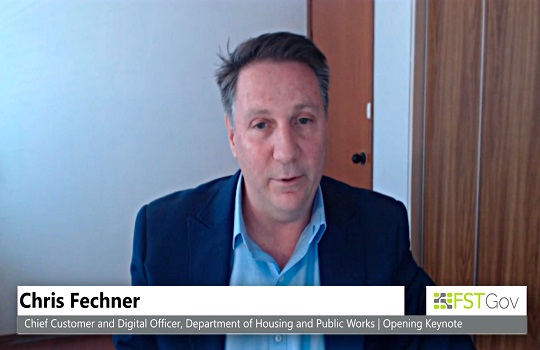
For the Queensland Government to “remain relevant” and citizen-focused into the 21st century, Chris Fechner, the Sunshine State’s first chief customer and digital officer, has called for the creation of a “digital roadmap” to clearly define state agencies’ digital priorities and agenda for the future.
As part of the roadmap, Fechner stressed the importance of embracing “new ways of working” in light of Covid response, as well as leveraging emerging technologies, overhauling longstanding legacy systems, and improving cross-agency data sharing to better meet citizen needs into the future.
Presenting the opening keynote of the 2020 FST Government Queensland eConference, Fechner addressed the impact of the Covid-19 crisis on the Queensland Government. An increased reliance on digital services by Queenslanders throughout this time has revealed significant opportunities to enhance front-line citizen services and create a more digitally inclusive government.
Adopting a clearly defined digital agenda will, Fechner believes, allow government agencies to deploy cohesive, streamlined, and customer-focused services. This will enable public agencies to meet growing customer expectations, as well as better interact with individuals and businesses who desire, and increasingly expect, a “one government” approach – effectively, a single, all-in-one touchpoint to access multiple government department services.
A key priority for the Government throughout the pandemic has been in maintaining service continuity, Fechner said.
While praising the Government’s largely successful push to rapidly digitise services and maintain citizen access following the initial lockdowns, Fechner acknowledged the effort was “not an easy” one.
In July, at the height of the nation’s Covid lockdowns, online traffic to government online services surged as a record number of Australians sought welfare assistance and other government support services.
Inevitably, the challenges faced during this time, including support for new remote working capabilities and the increased pressure to meet “rising customer expectations” in digital service portals, emphasised the need within Government for a comprehensive “digital game plan” to ensure it can continue to deliver a high level of service to its constituents.
Fechner stressed that it was “no longer a choice” whether the Government could or should increase its pace of digital transformation – continuous change will be fact of life for the public agencies in order to meet constituent’s increasing demands for digital services and expectations for responsive, high-quality service delivery.
A customer-led approach
Enabling “seamless, consistent, and personalised interactions” can vastly improve government digital services for customers, Fechner said.
While over half of all Australians report that they are satisfied with digital government services, 56 per cent still experience problems when accessing those services, a study by BCG’s Centre for Digital Government found.
Data from the Queensland Government appears to align with this. While customer satisfaction with the state Government has increased 11 per cent since the onset of the pandemic, it peaks at only 65 per cent overall, leaving “some way to go” for improvement, Fechner admits.
By comparison, Service NSW has been focusing “for a number of years” on making service delivery for customers “accessible and simple”, he said. This has clearly borne fruit for the state, which achieved an impressive 97 per cent customer service satisfaction rating in 2019.
For Fechner, service is a crucial benchmark for good governance, with “trust in government really closely correlated [with] service delivery”.
Enlisting helpful and knowledgeable staff, he said, is “the most critical factor” in improving future experiences within the Sunshine State, with “other jurisdictions [already realising] the importance of customer service”.
Improved cross-agency data-sharing would ensure staff better “understand the needs” of constituents, and support evidence-led enhancements to front-line CX. He stressed the importance of both “direct” and “indirect data” from frontend engagement platforms to better gauge customer needs and “continuously improve… service delivery”.
Individuals see government as a single entity, Fechner added. As such, there is an understandable aversion to engaging with different government agencies on separate platforms – a process that often requires customers to repeat information or prove their identity multiple times.
Moreover, he said, customer service failings in one government department can reflect poorly on government as a whole.
“Every time [a customer experiences] a service delivery failure in one department, it reflects on trust or the confidence in the government overall.”
It is therefore crucial that agencies collaborate to address this discord.
Fechner stressed the importance of supporting further cross-agency collaboration to “leverage investment opportunities” for the “mutual benefit” of collaborating agencies.
By streamlining customer service interactions and equipping staff with the skills to deliver “exceptional customer service,” the Queensland Government can better engage with citizenry and form “ongoing relationships” with individuals and businesses.
An integrated approach
Underpinning an integrated approach to customer service, agencies must renew their focus on cross-agency data sharing and a better data governance framework.
Fechner admits that siloed and incomplete data has caused problems for the Queensland Government in the past. By utilising shared data between agencies, government can form a clearer picture of what constituents need and how they want to interact, helping data and design teams enhance and streamline front-end citizen services and ensure supporting backend systems are in place.
“We need to have enough data to understand how we connect [customer] services… to provide those critical services to our citizens and businesses.”
Of course, seamless data exchange requires platforms and systems that are capable of ingesting, aggregating, and analysing increasingly complex datasets from multiple government agencies; the significant legacy infrastructure burden within Queensland’s public sector government could ultimately stymie these efforts.
Fechner admits that, in the past, the Queensland Government relied overwhelmingly on “large, complex systems” that were created “based on what we [thought] our citizens and businesses [needed], and not what they tell us they need”. Consequently, customer needs were failing to be met.
Instead, Fechner has urged the Queensland Government adopt an agile approach to infrastructure management that can meet today’s increasingly rapid technology lifecycles, developing and adopting tailored solutions that “last as long as they’re needed”, rather than being active for potentially “decades”.
“Queensland has quite a large legacy problem and we need to change and disrupt that investment profile about having long-running, large monolithic systems, because they simply are not responsive enough to meet the needs of our customers now.”
What is more, the Government needs to embrace agile ways of working that “enable speedy direction shifting”, enabling it to respond to “digital innovation and government priorities” at pace.
Enterprise architecture should be designed to host common platforms for data and identity integration, in effect creating a continuous customer service experience, he said.
Fechner envisions an integrated and seamless future for the government’s frontend service platforms. Much like the Federal Government’s my.gov service portal, he is keen to see Queenslanders provided with a “single login” to access all government services.
He concedes, however, this vision has considerable hurdles, including substantial legacy, to overcome.
Ensuring equitable digital access for all Queenslanders has also faced challenges in the geographically immense and socially diverse state. A key input from regional forums conducted throughout the pandemic in Queensland was the urgent need for “access to connected services”.
“In some areas of regional Queensland, internet connectivity is so poor and travel times so long that often our citizens are excluded, or they get lower levels of services than those of their metro cousins.”
A ‘digital roadmap’ could serve to best articulate the Government’s digital priorities and agenda, and provide “clearly defined targets to focus and synchronise efforts”, he said.
He suggests the roadmap should also incorporate strategies to reduce technical debt and modernise “archaic legacy systems”.
“For government to remain relevant in the 21st century, we need to review and change our mindset to look at different ways of working.”
However, there is much to be learned in the journey itself, not just the destination. The Queensland Government, he said, should not underestimate the “good” that can be achieved while searching for a “perfect” solution.





